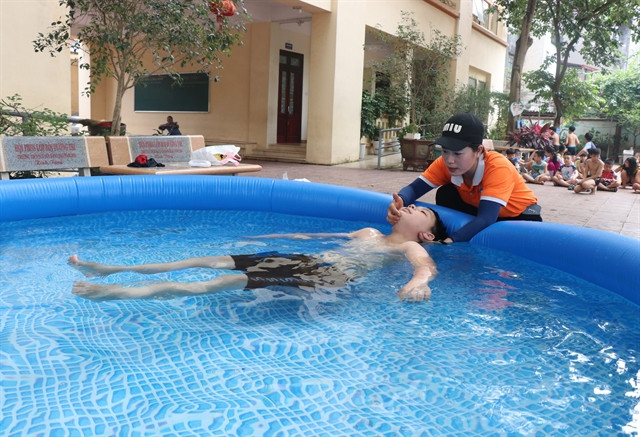 |
| A student at Tiền An Primary School in Bắc Ninh City learns how to float. — VNA/VNS Photo |
The Ministry of Education and Training has introduced guidelines for school safety and decreed measures to reduce child-related traffic accidents.
Still, severe accidents continued unabated in 2024.
Several notable examples include the accident at Bùi Thị Xuân Primary and Secondary Ethnic Boarding School in Đắk Lắk Province on September 16, where a seven-year-old student was killed after being struck by a car driving into the school premises.
The following day, a 5th-grade student at Đại Thắng Primary School in Hà Nội suffered a serious injury after falling from the second floor of the school building.
Last week, the capsizing of a boat in the Mực River in Thanh Hóa Province claimed the lives of two children, who were out enjoying a boat trip with their friends.
The situation is not much better when looking at the bigger picture.
Official statistics indicate a decline of around four per cent in accident-caused child fatalities in Việt Nam over the past few years, which translates into about 100 fewer child deaths annually.
The figure is encouraging, but, as some experts put it, 'still falls short of the long-term goal of injury prevention', especially considering the persistently high mortality caused by drowning and traffic accidents, which claim approximately 3,600 child lives annually.
The ministry cited ineffective communication campaigns as the main factor impeding its measures. It also held the school accountable for the child's death in Đắk Lắk, which neglected regulations to allow a car driving on its premises.
Some experts suggested using local funds to expand the 'safe house' model to create a safe environment for children.
Key safety features in such houses include fences around water, covering wells and water tanks. Dangerous items would be locked away, windows strengthened with sturdy bars and kitchens childproofed with barriers and gates.
Dương Khánh Vân, a World Health Organization expert in Việt Nam, emphasised the need for a multi-faceted approach to prevent child drowning in Việt Nam, including safety training and community-based childcare, especially during flood seasons.
She also highlighted the importance of building fences around water bodies, installing warning sites and enforcing mandatory life jacket use for children.
According to Chairman of the Education Council at Đinh Tiên Hoàng Highschool in Hà Nội, Nguyễn Tùng Lâm, while schools have comprehensive safety regulations, the key issues lie in ensuring strict adherence.
He said more rigorous inspections and heavier penalties for violations were necessary to keep child accidents at bay.
Director of the Department of Children's Affairs, Đặng Hoa Nam, highlighted the significant impact of child injury prevention programmes, which can reduce child mortality rates by approximately half.
He thus emphasised the need for increased investment in such programmes, noting that the costs would be outweighed by the benefits. He urged local governments to prioritise child safety in their budgets and allocate more resources for child-safety initiatives.
According to the Ministry of Health, more than 370,000 children suffer injuries in Việt Nam annually, of which about 6,600 succumb to the injuries, representing about one-third of the figure. — VNS